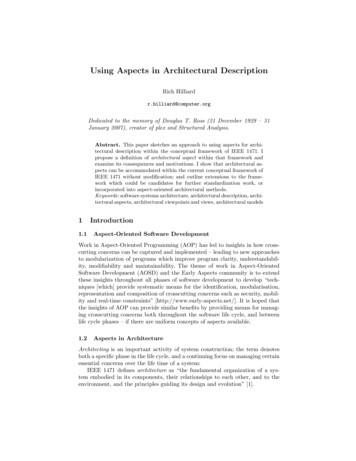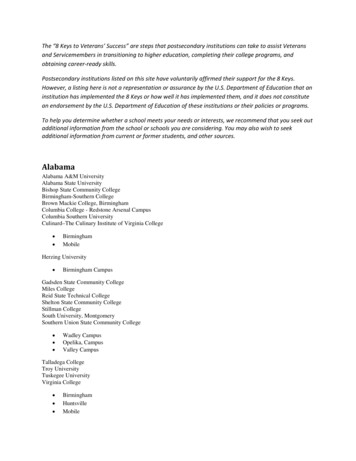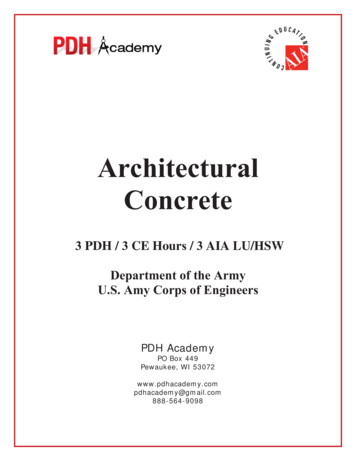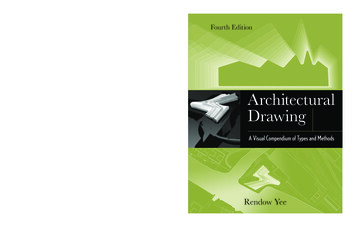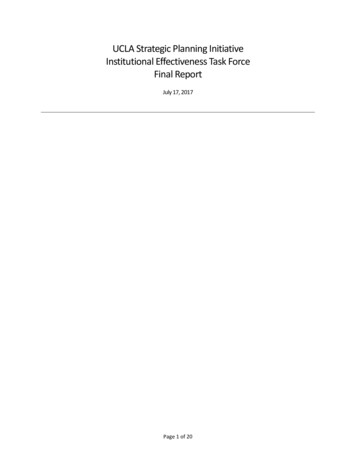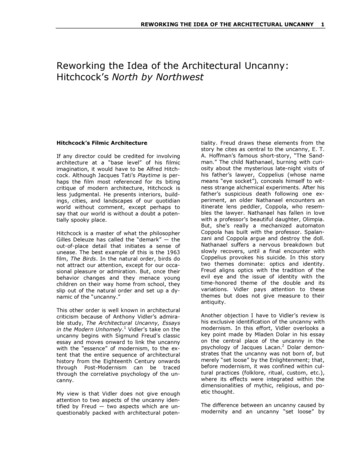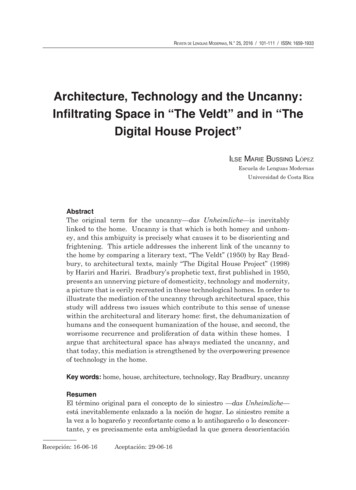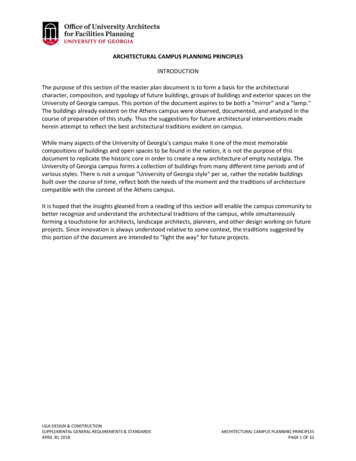
Transcription
ARCHITECTURAL CAMPUS PLANNING PRINCIPLESINTRODUCTIONThe purpose of this section of the master plan document is to form a basis for the architecturalcharacter, composition, and typology of future buildings, groups of buildings and exterior spaces on theUniversity of Georgia campus. This portion of the document aspires to be both a "mirror" and a "lamp."The buildings already existent on the Athens campus were observed, documented, and analyzed in thecourse of preparation of this study. Thus the suggestions for future architectural interventions madeherein attempt to reflect the best architectural traditions evident on campus.While many aspects of the University of Georgia's campus make it one of the most memorablecompositions of buildings and open spaces to be found in the nation, it is not the purpose of thisdocument to replicate the historic core in order to create a new architecture of empty nostalgia. TheUniversity of Georgia campus forms a collection of buildings from many different time periods and ofvarious styles. There is not a unique "University of Georgia style" per se, rather the notable buildingsbuilt over the course of time, reflect both the needs of the moment and the traditions of architecturecompatible with the context of the Athens campus.It is hoped that the insights gleaned from a reading of this section will enable the campus community tobetter recognize and understand the architectural traditions of the campus, while simultaneouslyforming a touchstone for architects, landscape architects, planners, and other design working on futureprojects. Since innovation is always understood relative to some context, the traditions suggested bythis portion of the document are intended to "light the way" for future projects.UGA DESIGN & CONSTRUCTIONSUPPLEMENTAL GENERAL REQUIREMENTS & STANDARDSAPRIL 30, 2018ARCHITECTURAL CAMPUS PLANNING PRINCIPLESPAGE 1 OF 32
EXISTING UGA BUILDING STYLESVERNACULAR/GEORGIAN/NEO-CLASSICALBelow are some examples of Vernacular/Georgian/Neo-Classical building styles found on the UGAcampus and a brief indication of their characteristics.Examples- Old College- New College- Phi Kappa Hall- Chapel- Demosthenian HallObservations- Domestic scale – unassuming character with exception of the Chapel- Generally more wall than window- Visual tension between proportions of opening and wall (i.e., the proportions of the wall areoften more dominant than the proportions of window)- Architectural elements are often integral to the building’s construction- Vertical bay structure and vertically oriented openings- Spartan vocabulary, restrained use of ornament- Pragmatic elements modulate facade (e.g., downspout, chimneys, entrances)- Facade is not overly “deep” except when a portico element is added to recognize entryNew CollegeOld CollegePhi Kappa HallUGA DESIGN & CONSTRUCTIONSUPPLEMENTAL GENERAL REQUIREMENTS & STANDARDSAPRIL 30, 2018ChapelDemosthenian HallARCHITECTURAL CAMPUS PLANNING PRINCIPLESPAGE 2 OF 32
EXISTING UGA BUILDING STYLESBEAUX-ARTSBelow are some examples of Beaux-Arts building styles found on the UGA campus and a brief indicationof their characteristics.Examples- Peabody Hall- Memorial Hall- Business SchoolObservations- Monumental scale compatible with domestic core of campus- Range of proportion of window to wall- System of ornamentation may not be directly tied to constructional technique, rather it is tied tobroader cultural ideals related to building type (i.e., you know it is a “library” by its appearance,but what you see may or may not directly be related to how it was built)- Use of sophisticated proportioning systems- Division into 3 parts vertically and horizontally – clear hierarchy of parts- Facade is “sculpted” in 3 dimensions as if carved from a block of clay- Preference for symmetry, however complex overlapping local symmetries are sometimes usedto produce localized picturesque effects- Generally incorporates historical referencesPeabody HallFine Arts BuildingUGA DESIGN & CONSTRUCTIONSUPPLEMENTAL GENERAL REQUIREMENTS & STANDARDSAPRIL 30, 2018ARCHITECTURAL CAMPUS PLANNING PRINCIPLESPAGE 3 OF 32
EXISTING UGA BUILDING STYLESMODERN AND TRADITIONALBelow are some examples of Modern and Traditional building styles found on the UGA campus and abrief indication of their characteristics.Examples- Library- Fine Arts Building Additions- Sanford HallObservations- A more monumental scale- Recognition of frame construction techniques in aesthetic of vertical surface- Often more window than wall or an equivalent proportion of window and wall- Facade is “layered” as a series of flat, planar surfaces composed within the constraints of amodest dimension.- System of ornamentation is restrained, however attempts to relate constructional techniques tocultural ideals related to building type (i.e., you know it is a “library” by its appearance, and youhave an idea of how it was built)- Draws inspiration from history and ideas of contemporary lifeMain LibraryUGA DESIGN & CONSTRUCTIONSUPPLEMENTAL GENERAL REQUIREMENTS & STANDARDSAPRIL 30, 2018ARCHITECTURAL CAMPUS PLANNING PRINCIPLESPAGE 4 OF 32
EXISTING UGA BUILDING STYLESMODERN AND CONTEMPORARYBelow are some examples of Modern and Contemporary building styles found on the UGA campus and abrief indication of their characteristics.Examples- Chemistry Annex- Georgia Museum of ArtObservations- Vertical surfaces are less likely to be designed as “facades”- Overall massing dictates form – buildings less likely to participate in campus space making- Openings are “slots” or “zones” where wall surface is omitted rather than an incised opening- Character of building is particular to the whim of the architect, client, or donor- Building does not necessarily communicate an idea of what it is or how it was built- Unclear hierarchy of parts- Scale is indeterminate- Abstract form preferred over forms of “traditional building” (i.e., roofs, walls, doors, windows,are replaced with horizontal planes, vertical planes, and various kinds of apertures)- Preference for asymmetrical massing and the picturesque over symmetry- Notion of the Zeitgeist prevails, history and tradition are devalued – draws little upon immediatephysical contextChemistry AnnexGeorgia Museum of ArtUGA DESIGN & CONSTRUCTIONSUPPLEMENTAL GENERAL REQUIREMENTS & STANDARDSAPRIL 30, 2018ARCHITECTURAL CAMPUS PLANNING PRINCIPLESPAGE 5 OF 32
THE APPLICATION OF AMERICAN CAMPUS PLANNING PRINCIPLESTO THE UNIVERSITY OF GEORGIAThe planning principles exhibited on American campuses are truly a unique art form. While thetraditions of campus planning in the United States are closely related to attitudes concerning buildingand the landscape developed between the 16th and 19th centuries in England, France, and Italy, theapplication of these principles to the built form of the university is an art form, which evolved principallyin this country. The close relationship between built form and the landscape is a characteristic ofcampus planning that is the taproot of this art form. From Thomas Jefferson’s University of Virginia, toSaarenin’s Cranbrook Academy, this tradition remained unbroken until the Second World War.One of the most readily identifiable characteristics of this tradition was the creation of exterior spaces,which could be likened to interior rooms. In the diagram illustrated in Figure 1, a prototypical room isdrawn alongside a university quadrangle of similar proportions. Nearly everyone is familiar with thesense of enclosure and protection afforded by a room’s bounding surfaces – walls enclose space;windows admit light and air while permitting views to the exterior world; doors permit access; andtypically there is some element of focus within the room, perhaps a hearth. It is readily evident thatevery element performs a role supporting the larger notion of “room.” That is, walls alone do not theroom make. The interdependency of elements and the specialized tasks they play relegate elements ofthe room to hierarchical roles in the overall composition. That is a door to the room will serve to frame aview of the room’s principal feature – the hearth, and all along the corners of the room will besubservient to both the former and later elements.Likewise, the exterior room of a campus quadrangle has features, which might be seen as analogous tothat of a traditional interior room. The library may dominate the composition in much the same manneras the hearth, while a pair of buildings axially disposed across the quadrangle from this principal featuremight serve the same threshold purposes as that of a door. One might readily see that a successfulcomposition of a college quadrangle requires that the buildings operate in concert with one another.Sometimes buildings are called upon to play more assertive roles that of a “hero,” like the library, or thematching buildings forming the campus threshold. The heroic buildings, however, require substantialamounts of good “soldier” buildings to form the backdrop against which these more assertive buildingsmight be seen.In planning and building a new campus or on a portion of an existing campus it is very important tounderstand the role that individual buildings are required to play. Too many heroic structures would belike a room full of guests all talking at the same time. Too few heroic buildings would be like a partywhere none of the guests ever arrived — a bit of a bore. In planning a successful campus composition,one seeks to strike a balance between the “heroes” and the “soldiers.” Experience has shown that everytrustee, donor, president, dean, every department chair, or faculty member, usually like to view their“new building” as aspiring to be a “hero.” And, while much might be said of the heroic nature of thecommon foot soldier, it is recommended that the creation of heroic buildings on college campuses belimited to those building types which embody and relate the most universal and lofty aspirations of theentire institution — churches, libraries, places of assembly, etc.UGA DESIGN & CONSTRUCTIONSUPPLEMENTAL GENERAL REQUIREMENTS & STANDARDSAPRIL 30, 2018ARCHITECTURAL CAMPUS PLANNING PRINCIPLESPAGE 6 OF 32
Main LibraryMain LibraryFigure 1UGA DESIGN & CONSTRUCTIONSUPPLEMENTAL GENERAL REQUIREMENTS & STANDARDSAPRIL 30, 2018ARCHITECTURAL CAMPUS PLANNING PRINCIPLESPAGE 7 OF 32
CAMPUS BUILDING TYPOLOGYTHE EDGE-DEFINING TYPEThis building type often performs the role of the common foot soldier, but it may also take on heroicassignments. The generic configuration of the type is that of an elongated rectilinear volume. Mostoften entry is achieved on the center of one of the long faces, however edge entries, or entry from oneof the narrow elevations is also possible (see facade guidelines). This building type commonly aligns itseaves and ridgelines, not the gable end, to the quadrangle thus reinforcing the geometry of this exteriorroom. A central corridor gives access to the rooms. Typically the corridor is double loaded, however insome instances a single loaded corridor may serve the needs of the program. The length of this buildingtype may vary from 120 feet to 300 feet, while the width of the type is generally in the neighborhood of45-90 feet. When this type exceeds the 90 foot width dimension natural lighting and ventilation of theinterior spaces becomes impossible. Thus, depending upon the actual intended use of buildings of thistype, care should be given to the width of the block.There are a variety of methods for distributing this type in a campus plan (Figure 2).-Illustrates this building type located as a central element on the long side of a campusquadrangle – the building performs both the role of edge definer and central focus.Much the same might be said about the positioning of the type in this configuration, howeverbecause the building alone forms the edge of the narrow side of a long quadrangle, it tends totake on a more heroic dimension.In this instance the type is paired to form both the wall to the quadrangle as well as a thresholdto the campus.The final illustration of this type in context is interesting because it presents its end elevation tothe major quadrangle of the campus while forming the edge of a new quadrangle behind thefirst building discussed in this drawing.Examples of this building type on the UGA campus are Old College and New College, at otherinstitutions, Nassau Hall, Princeton and Old East and Old West at UNC Chapel Hill. The type mightaccommodate housing, classrooms, laboratories, administrative activities, and a wide variety of otherfunctions. It is typically the most prevalent variety of building to be found on college campuses. Thistype along with the Centralized Type form the two essential building blocks of campus architecture fromwhich all other types might be derived.UGA DESIGN & CONSTRUCTIONSUPPLEMENTAL GENERAL REQUIREMENTS & STANDARDSAPRIL 30, 2018ARCHITECTURAL CAMPUS PLANNING PRINCIPLESPAGE 8 OF 32
End ElevationFaçadeVariation48’ – 70’120’ – 300’Typical PlanPlan in ContextFigure 2UGA DESIGN & CONSTRUCTIONSUPPLEMENTAL GENERAL REQUIREMENTS & STANDARDSAPRIL 30, 2018ARCHITECTURAL CAMPUS PLANNING PRINCIPLESPAGE 9 OF 32
CAMPUS BUILDING TYPOLOGYTHE CENTRALIZED TYPEThis building type is often associated with a heroic posture within a campus plan, however, the typemight defer to other buildings depending upon its specific context. The general configuration of the typeis that of a compact rectilinear volume, however other platonic forms are also associated with this typecircular, octagonal, or other centralized form. Entry is most often achieved on the center of one of thenarrow facades and the type most often presents its gabled end to the quadrangle thereby gaining acertain amount of visual attention. Generally the type houses one large open space internally — oftenconceived of as a space of assembly. The dimensions of the type vary dramatically and should bedetermined based upon a mitigation of the concerns of the context against those of the building’sfunction.There are a variety of methods for distributing this type in a campus plan, refer to Figure 3.- Illustrates this building in a central position on the long edge of a campus quadrangle (a positionanalogous to that of a hearth in a room)- The positioning of a pair of buildings around a principal campus axis forms both edge andthreshold to the quadrangle.- The placement of the type in this position affords four separate exposures – the building is seenin the round (from all sides). This later placement can present problems in servicing the buildingif the concerns of use are not properly mitigated against those of the campus context. A chapelor assembly hall might be well served by this location, while a dining hall might not work wellwith the context given an intensive service component of the program.Examples of this building type on the UGA campus are the Chapel and the Phi Kappa building, at otherinstitutions, the Rotunda at the University of Virginia and Whig and Clio Halls at Princeton. The typemight accommodate various assembly activities: chapel, lecture hall, gymnasium, dining hall, etc. Whenused in conjunction with the Edge Defining Type in a single unified composition an unlimited variety ofbuilding forms might be created.UGA DESIGN & CONSTRUCTIONSUPPLEMENTAL GENERAL REQUIREMENTS & STANDARDSAPRIL 30, 2018ARCHITECTURAL CAMPUS PLANNING PRINCIPLESPAGE 10 OF 32
Typical PlanFaçadeFigure 3UGA DESIGN & CONSTRUCTIONSUPPLEMENTAL GENERAL REQUIREMENTS & STANDARDSAPRIL 30, 2018ARCHITECTURAL CAMPUS PLANNING PRINCIPLESPAGE 11 OF 32
CAMPUS BUILDING TYPOLOGYTHE COMPOSITE TYPEWhile many contemporary building programs might not be readily addressed by either the EdgeDefining or the Centralized Types alone, in combination the two building types form the essentialcharacteristics of the Composite Type. It is more difficult to talk about general configurations of this typebecause the possible combinations and recombination of the basic “building blocks” of typology arelimitless. For an insight into the variety of possibilities see, N.C. Curtis, Architectural Composition,Cleveland: Jansen, 1927.The characteristics of how this building type might address a quadrangle are similar to those outlined inboth of the previous two types. Again the actual dimension of the type may vary dramatically, so onceagain a mitigation of the contingencies of the site against those of building use are highly recommended.Once again there are a variety of methods for distributing this type in a campus plan, Figure 4.- Illustrates the simplest form of the type – a Centralized Type has been joined with two flankingEdge-Defining Types to form an articulated wall to the quadrangle. The central element providesaccent to the quadrangle while the flanking volumes carry the “wall” of the space along theedge of the quad.- This illustration of the type is a much more complex combination of the campus building blocks.A central space of assembly is aligned with the axis of the quadrangle and is used in combinationwith a series of edge-defining volumes. A forecourt is formed between the campus quadrangleand the central volume, while an automobile forecourt is formed by the wings, which extenddownward at ninety-degree angles to the long axis of the quadrangle. To the far right, a servicecourt is formed, and to the top, edge-defining types wrap the centralized volume to form aninternal courtyard.- In comparison to the previous example, this configuration of the type is very tame. In fact, thetype is created by relocating the edge-defining elements at 90 degree angles to the positionoccupied in example one — thus, forming a forecourt. The advantage of this type is that largebuilding programs can be accommodated in this configuration without dimensionallyabandoning a 70-foot maximum building wing width.Examples of this building type on the UGA campus are the Fine Arts Building and the Business School, atother institutions — Bancroft and Mahan Halls at the United States Naval Academy, Annapolis. Mostcomplex programs can be accommodated by this typology.UGA DESIGN & CONSTRUCTIONSUPPLEMENTAL GENERAL REQUIREMENTS & STANDARDSAPRIL 30, 2018ARCHITECTURAL CAMPUS PLANNING PRINCIPLESPAGE 12 OF 32
Partial FaçadePartial PlanPlan in ContextFigure 4UGA DESIGN & CONSTRUCTIONSUPPLEMENTAL GENERAL REQUIREMENTS & STANDARDSAPRIL 30, 2018ARCHITECTURAL CAMPUS PLANNING PRINCIPLESPAGE 13 OF 32
CAMPUS BUILDING TYPOLOGYTHE COMPOUND TYPEIn many cases contemporary programs call for very large footprints to accommodate specializedactivities. While the advantage of these large footprints is that many activities can be located in anefficient proximity to one another, the liability is that these types of buildings often becomehermetically sealed and connections between interior spaces and the exterior world become severed.Faculty, staff, and students can find themselves living out their entire academic life in these “megastructures” without ever stepping foot outside of their own domain. In short the danger of these“academic malls” are that they often do not contribute in an effective manner to the overall well-beingof the university. However, when properly designed these big buildings can indeed contribute well tothe life of a campus.Of primary interest is care given to issues of scale and proportion. Wherever possible, the massivenessof the building should be mitigated by elements in concert with the human scale of the campusenvironment. The Typical Plan in Figure 5 illustrates an Edge-Defining Type used as a frontispiece, orhead house, for a much larger building mass. The site section diagrams located above the typical plandrawing also illustrate two techniques for masking the massiveness of the “large footprint” building. Theuphill site illustrates a laboratory building nestled into the grade to minimize the impact of its height andgirth, while the downhill site illustrates a parking structure carved into the hillside behind an academicbuilding. The upper deck of this later building is then landscaped and treated as a garden terrace.Again, there are a variety of methods for distributing this type in a campus plan, Figure 5.- Illustrates a very large laboratory building, which is flanked by two classroom buildings andheaded up by an administrative/office wing, which mediates a connection to the quadrangle.- Is a center for continuing education, which presents a face both to the outside world (bottomedge) and to the campus quadrangle (right edge). These wings, joined by a rotund element maskthe large parking structure located behind. Access to the parking structure is from the extremeright edge of the footprint. It should be noted that care would be given to the surface of theparking structure to create a “handsome” facade in concert with the vocabulary of the campus.- Illustrates a large student center with large dining halls, meeting rooms, ballrooms, andrecreational spaces. The configuration presents a forecourt to the campus quadrangle using twoEdge-Defining and one Centralized Type in order to mask the large footprints of the bigassembly halls. To the far right a service court provides access for deliveries and waste removal.Successful examples of this building type are Cabel Hall at the University of Virginia, the Physics andAstronomy Building at Johns Hopkins University, the Student Center at Carnegie Mellon, Barton Hall atCornell University, and the original buildings on the campus of Duke University.UGA DESIGN & CONSTRUCTIONSUPPLEMENTAL GENERAL REQUIREMENTS & STANDARDSAPRIL 30, 2018ARCHITECTURAL CAMPUS PLANNING PRINCIPLESPAGE 14 OF 32
Down-Hill Site45’ – 70’45’ – 70’120 120’ Up-Hill SiteTypical PlanFigure 5UGA DESIGN & CONSTRUCTIONSUPPLEMENTAL GENERAL REQUIREMENTS & STANDARDSAPRIL 30, 2018ARCHITECTURAL CAMPUS PLANNING PRINCIPLESPAGE 15 OF 32
MASSING DIAGRAMSThese series of diagrams are intended to suggest the limitless rational combinations and recombinationsof the “building blocks” to form more complex compositions appropriate to elaborate programs. Eachdiagram builds upon the previous drawing suggesting a process of elaboration and combination. Notethat the massing is not dependent upon a singular response to issues of symmetry/asymmetry,center/edge, base condition, or roof. Both designers and members of the campus community areencouraged to imagine their own formal inventions as an extension of this exercise.Figure 6Figure 7Figure 8UGA DESIGN & CONSTRUCTIONSUPPLEMENTAL GENERAL REQUIREMENTS & STANDARDSAPRIL 30, 2018ARCHITECTURAL CAMPUS PLANNING PRINCIPLESPAGE 16 OF 32
CAMPUS FAÇADE TYPOLOGYINTRODUCTIONEach of the facade variations illustrated herein derives from the previously mentioned observation,documentation, and analysis of the UGA campus. The proportions of openings and wall surfaces arederived from UGA traditions and may not be directly applicable to other campuses, however, many ofthe techniques for creating hierarchical “readings” of the facades are generic in nature.Typically this study recognizes two generic architectural conditions — that of the wall and that of theframe. Both types are to be found alone and in combination on the UGA campus. Once again, theobservations made herein are not an attempt to advocate specific styles, however, it is explicitly theintention of this portion of the document to encourage the development of rationale for the verticalsurfaces. Thomas L. Schumacher’s, “Scull and the Mask,” as well as, “The Palladio Variations,” (CornellJournal of Architecture, New York: Rizolli) are excellent starting points for discussion of facade makingthemes. Since a building on a college campus is likely to be kept in service for in excess of 100 years, it isimportant to give the design of facades considerable attention.UGA DESIGN & CONSTRUCTIONSUPPLEMENTAL GENERAL REQUIREMENTS & STANDARDSAPRIL 30, 2018ARCHITECTURAL CAMPUS PLANNING PRINCIPLESPAGE 17 OF 32
CAMPUS FAÇADE TYPOLOGYTHE PLANAR FAÇADE WITH SIMPLE OPENINGSThis type is derived in part from New College. The aesthetic derives from bearing wall constructiontechniques. The façade type is characterized by a series of regularly spaced windows of equaldimension. Not only do the windows act as “figure” in the composition of the façade, but the spacesbetween are also imbued with figural properties. That is, the windows are as interesting to the eye asthe wall.Windows read as discrete architectural elements positioned within the fabric of the wall. The head ofthe window is characterized by a lintel or flat arch, which occasionally serves as a location forornamentation. The sills of the window are often stone and project from the surface of the wall.Following the logic of bearing wall construction, the general proportion of each window is that of avertical rectangle, in this case a square root of two or golden section rectangle. The windows aretypically double hung and subdivided into smaller panes.In this façade type, the ground floor of the building is given special prominence by rustication or by beltcoursing. This treatment permits the composition of the wall to relate well to the ground plane. Typicalof many buildings on UGA’s campus, the building is capped by a gabled metal roof that is selectivelyarticulated with masonry elements (chimneys, cupolas, etc.). There are examples of very successfulbuildings on the UGA campus in which the roof is not expressed. Typically, however, these buildings(such as Peabody Hall) terminate the wall with a cornice, or other element, which forms a distinct profileagainst the sky.Figure 9UGA DESIGN & CONSTRUCTIONSUPPLEMENTAL GENERAL REQUIREMENTS & STANDARDSAPRIL 30, 2018ARCHITECTURAL CAMPUS PLANNING PRINCIPLESPAGE 18 OF 32
Planar Façade Variations- In this series all of the openings in the façade are created through the use of equally spacedwindows of identical dimension. Hierarchy is achieved by manipulating the reading of the wallsurface and by adjusting the relationship between the opening and the wall.Variation A- This façade uses a “surround” treatment to distinguish the windows on the first floor from thoseon the ground and upper floor levels. This treatment may be useful in breaking up themonotony of a façade composed of regularly spaced windows. Additionally, the treatment givesdistinction to the first story above the ground level as a place of prominence within the building.Variation AVariation B- This façade uses belt courses and rustication to produce a horizontal effect. This treatment maybe an appropriate strategy for making tall facades to appear more in scale with a lower context.Additionally, the treatment may be appropriate when the building is intended at a “background”element in a composition wherein the intention is not to have the eye come to rest on thisparticular building.Variation BUGA DESIGN & CONSTRUCTIONSUPPLEMENTAL GENERAL REQUIREMENTS & STANDARDSAPRIL 30, 2018ARCHITECTURAL CAMPUS PLANNING PRINCIPLESPAGE 19 OF 32
Variation C- This façade develops a strong reading of “center” by creating an intersecting gable at themidpoint of the composition. Addition of an attic element and the positioning of chimneyscreate a strong sense of center. This may be an appropriate treatment when the building is animportant element of a group plan, such as the main building of a college, or a prominentbuilding on an open space or quadrangle.Variation CVariation D- This façade is characterized by a development of localized centers at the extremities of thefaçade. The result is a dual centered façade. The use of a segmental gable that penetrates theeaves line of the roof, strategically positioned chimneys, and downspout, create an emphasisupon the edges of the overall composition. This treatment may be used in conjunction withelements of Variation C to create a hybrid that emphasizes both center and edgesimultaneously. The type may be most appropriate for buildings with multiple entries, forbuildings that attempt to downplay their hierarchical importance on a quadrangle or openspace, or for buildings, which contain more than one academic department.Variation DUGA DESIGN & CONSTRUCTIONSUPPLEMENTAL GENERAL REQUIREMENTS & STANDARDSAPRIL 30, 2018ARCHITECTURAL CAMPUS PLANNING PRINCIPLESPAGE 20 OF 32
CAMPUS FAÇADE TYPOLOGYTHE PLANAR FAÇADE IN RELIEFThis type is very similar to the previous example, however it differs in that the surface is developed interms of relief or depth of the wall surface. The amount of relief may vary from only a few inches to thatof many feet (in the case of a freestanding portico). Through the introduction of relief, a hierarchicalreading of the openings (windows and doors) can be developed.Figure 11UGA DESIGN & CONSTRUCTIONSUPPLEMENTAL GENERAL REQUIREMENTS & STANDARDSAPRIL 30, 2018ARCHITECTURAL CAMPUS PLANNING PRINCIPLESPAGE 21 OF 32
Planar Facade in Relief Variations- In this series all of the openings in the facade are created through a use of equally spacedwindows of identical dimension. Hierarchy is achieved by manipulating the degree of surfacerelief either in front of or behind the dominant wall plane.Variation A- This facade uses a modestly scaled series of pilasters in front of the dominant wall surface tocreate a centralized reading and emphasis upon the entry. An element breaking the roof line(perhaps an elevator core) further emphasizes the centrality of the composition.Variation AVariation B- This facade creates a large centralized element by “excavating” or carving into the dominantwall plane in order to create a series of vertical openings articulated as pilasters. The verticalscale of this gesture suggests a more monumental and perhaps heroic character than VariationA.Variation BUGA DESIGN & CONSTRUCTIONSUPPLEMENTAL GENERAL REQUIREMENTS & STANDARDSAPRIL 30, 2018ARCHITECTURAL CAMPUS PLANNING PRINCIPLESPAGE 22 OF 32
Variation C- This facade balances emphasis to both center and edge by once again “excavat
document to replicate the historic core in order to create a new architecture of empty nostalgia. The University of G eorgia campus forms a collection of buildings from many different time periods and
